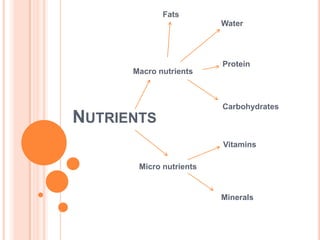
Nutrients
- 1. Fats Water Protein Macro nutrients Carbohydrates NUTRIENTS Vitamins Micro nutrients Minerals
- 2. VITAMINS MICRONUTRIENT WATER SOLUBLE FAT SOLUBLE B group vitamins (B1, B2, B3, A, D, E & K vitamins B6, B12) Found in fat soluble foods such Vitamin C as chees, meat, eggs and Found in watery food such as yellow and green vegies vegetables, milk and meat Soluble in fat Soluble in water Travels via the lymph system Travels via the blood Stored in the body Not stored within the body
- 3. VITAMIN A Normal vision Healthy lining cells e.g. skin, lungs Bone and teeth formation Healthy skin, hair, mucous membranes Essential in reproduction by helping to produce new cells Liver, butter, cheese, eggs
- 4. VITAMIN D Helps absorption of calcium and phosphorus Increases deposits of calcium and phosphorus into bone Both of these functions contribute to bone growth Sunlight, eggs, butter, cream
- 5. VITAMIN E Acts as an antioxidant – substances that prevent damage to the body by free radicals substances produced when oxygen is metabolised, an overload causes build up of cholesterol deposits in the arteries, which can cause cancer and heart disease Vegetable oils, wholegrain cereals, nuts
- 6. VITAMIN C (ASCORBIC ACID) Collagen production Assists the absorption of iron Healing wounds, protecting against injury and infection Production of hormones Citrus fruits, tomatoes, capsicum
- 7. CALCIUM MICRONUTRIENT Formation, hardening and maintenance of bones and teeth. Calcium is stored in the skeleton, but is not static Nerve and muscle functioning e.g. heart Blood clotting Dairy products, green leafy vegetables, fish
- 8. IRON Formation of haemoglobin to carry oxygen in the blood. Most iron in the body is in haemoglobin, but is also stored in bone marrow, spleen and liver Formation of myoglobin which stores oxygen in muscle cells Liver, kidney, green leafy veges, wholegrain cereals
- 9. SODIUM Transmission of nerve impulses and muscle contraction Controlling blood pressure Maintains osmotic pressure and water balance within the cell Table salt, meat
- 10. FLUORIDE Strengthens tooth enamel against dental caries, especially in developing teeth Seafood, fluoridated water
- 11. PHOSPHORUS Mineralisation (hardening) of bones Energy metabolism Balance of body fluids Cereals, peanuts, chicken
- 12. WATER MACRONUTRIENT The body is made up of 60% water within and surrounding cells 6 – 8 glasses a day is required Inadequate water consumption causes dehydration, resulting in headaches, fatigue Important for chemical reactions to occur in the body. Every body function requires water Water is needed to transport the nutrients to the cells for excretion lubricates the joints helps regulate body temperature Sources are tap water, meat, fish, milk, tea
- 13. FATS MACRONUTRIENT One gram of fat provides the body with 37 kilojoules of energy Small amounts of fat have very important functions Helps protect vital organs Unsaturated fats are better for you then saturated fats 4 types of fats: saturated, trans, monounsaturated, polyunsaturated Assists in the absorption and transport of fat soluble vitamins A, D, E and K
- 14. PROTEIN MACRONUTRIENT One gram of protein provides the body with 17 kilojoules of energy Protein is especially important during times of growth such as adolescence and pregnancy Protein is made of many amino acids Two types of protein: Complete (meat, fish, cheese, milk) Incomplete (vegetables, grains, nuts) Protein is required for the growth, repair and maintenance of all body tissues It also helps regulate body processes like water balance
- 15. CARBOHYDRATES MACRONUTRIENT Eating one gram of CHO provides the body with 16 kilojoules of energy 55% of our energy should come from complex carbohydrates such as wholegrain cereals, fruit and vegetables. Complex CHO assist with digestion and help with disease prevention There are two main groups of CHO: 1. simple sugars (monosaccharides) From honey, fruit & vegetables An example of a simple sugar is glucose (most soluble, easily absorbed CHO) 2. complex CHO (polysaccharides) From wholegrain cereals, fruit and vegetables (raw and skin), nuts, legumes Examples of complex CHO are starch and fibre
- 16. CARBOHYDRATES Carbohydrates are a major source of energy They can be used very efficiently by the body, especially systems such as the central nervous system Eating cellulose (from polysaccharides) provides the body with fibre or roughage, to speed up the metabolism and prevent constipation Fibre can therefore be a preventative/protective factor against dietary diseases such as heart disease, bowel cancer, obesity and diabetes Cereals, pasta, rice, fruit, vegetables, sugar, jam